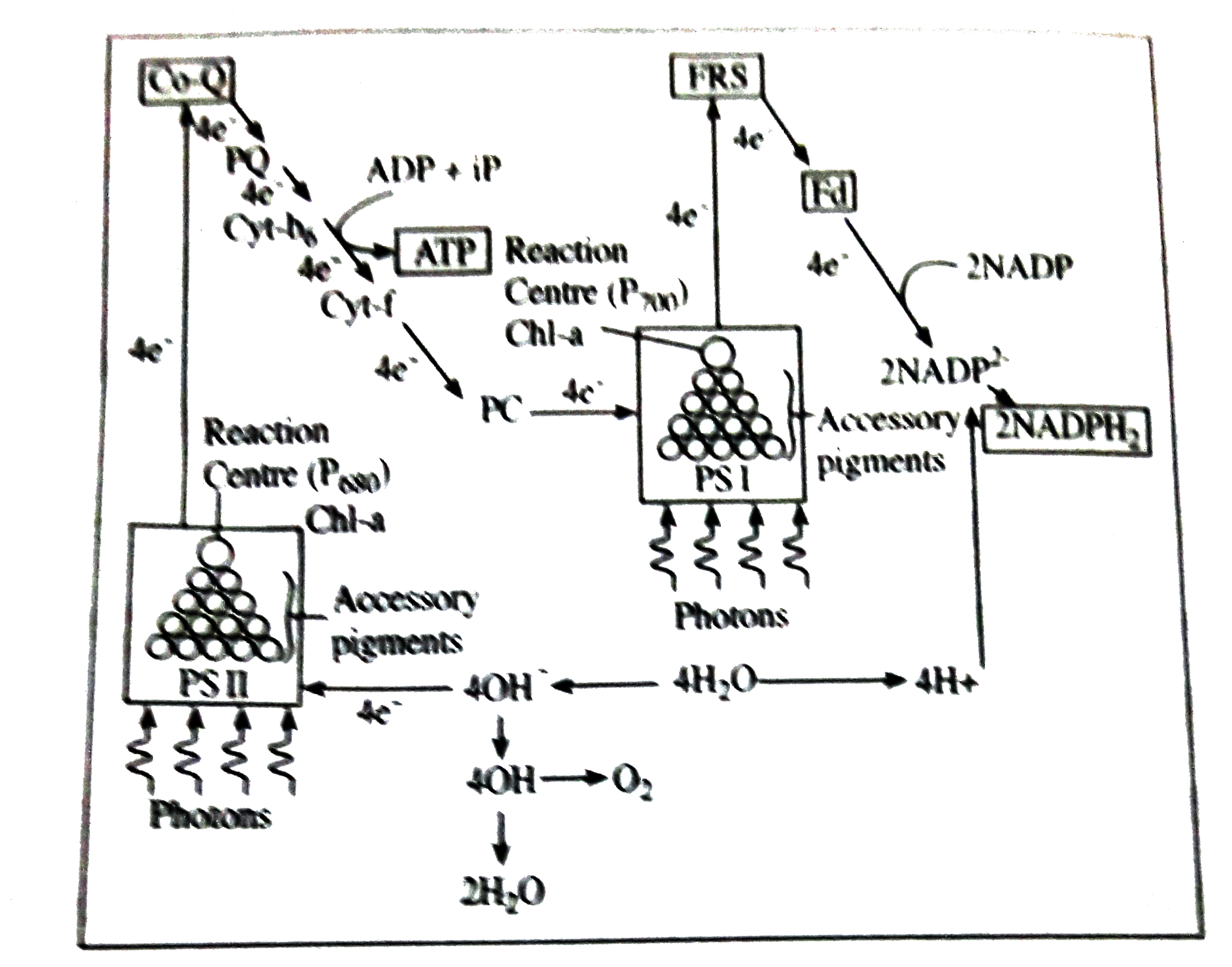What is photophosphorylation ? Describe noncyclic photophosphorylation with schematic representation. Give its significance.
Text Solution
1. Photophosphorylation : The process by which energy rich ATP molecules are synthesized using solar energy is called photophosphorylation.
2. Noncyclic photophosphorylation : Noncyclic photophosphorylation is a kind of photophosphorylation which involves a continuous unidirectional flow of electrons from water to PS II, from PS II to PS I and finally to NADP. It is completed in the following steps :
(i ) Photoexcitation of photosystem I (PS I) :
(1) The photosynthetic pigments of PS I (photosystem I ) sbsorb the energy of photons which is funnelled to the reaction centre P700 (chlorophyll-a).
(2) The energy of photons are converted into the energy of electrons which are raised to high energy level (orbit ) as chlorophyll-a is excited by the absorbing light .
(3) The electrons raised to high energy level are then accepted by FRS (Ferredoxin reducing substance).
(4) The electrons from FRs are transferred to ferredoxin (Fd) as a result of which it is reduced.

(5) The electrons from reduced ferredoxin is finally taken to NADP which is reduced to NADPH.
(6) NADP retains the electrons and becomes negatively charged, while P700 owing to loss of electrons becomes positively charged i.e., ionized.
(ii) Photoexcitation of PS II and flow of electrons from PS II to PS I :
(1) The photosynthetic pigments of photosystem II absorb the energy of photons which funnelled to the reaction centre of PS II, i.e., P680.
(2) The energy of photons is converted into the energy of electrons which are raised to high energy level.
(3) The electrons that are raised to high energy level are accepted by plastoquinone (PQ) leaving the reaction centre ionized. As a result of this PQ is reduced.
(4) The electrons from PQ then pass through an electron transport chain consisting of cytochrome-b6, cytochrome-f and phastocyanin during which they lose energy, i.e., de-energize.
(5) The de-energized electrons are transferred from plastocyanin to the reaction centre P700 of PS I. This shows that PS II replaces the lost electrons to PS I.
(6) During the transfer of electrons from cytochrome-b6 to cytochrome-f the released energy is utilized for the syntheses of ATP from ADP and iP.
(iii) Photolysis of water :
(1) P680 of pohotosystem II (PS II) behaves like a strong oxidizing agent. Therefore, it brings about the photolytic splitting of water molecule is called photolysis of water.
(2) When four electrons (e−) are removed from the reaction centre of PS II, they bring about the splitting of four water molecules into 4H+ and 4OH− ions.
(3) The hydroxyl ions (4OH−) thus produced donate the electrons to the reaction centre P680 as a result of which they become 4OH radicals.
(4) The 4OH radicals then react among themselves and form two molecules of water with the release of oxygen as shown under :
4OH→2H2O+O2
The net products of noncyclic photophosphorylation are ATP, NADPH and O2 . ATP and NADPH are utilized in the dark reactions of photosynthesis while oxygen is released.
Significance of photophosphorylation :
(1) Noncyclic photosphorylaion brings about the photolysis or water and release of molecular oxygen to the atmosphere.
(2) It involves the formation of ATP and NADPH2 Which possess the assimilatory power. This assimilatory power is utilized in the dark reaction of photosynthesis.
(3) ATP provides energy for the synthesis of carbohydrates during the dark reaction of photosynthesis.
(4) NADPH2 possesses reducing power which is utilized in the reduction of CO2 to carbohydrates during the reaction of photosynthesis.
|
Topper's Solved these Questions
- LONG ANSWER QUESTIONSBOOK - NAVNEET PUBLICATION - MAHARASHTRA BOARDCHAPTER - LONG ANSWER QUESTIONSEXERCISE - Respiration
4 Videos
- LONG ANSWER QUESTIONSBOOK - NAVNEET PUBLICATION - MAHARASHTRA BOARDCHAPTER - LONG ANSWER QUESTIONSEXERCISE - Reproduction in Plants
9 Videos
- LONG ANSWER QUESTIONSBOOK - NAVNEET PUBLICATION - MAHARASHTRA BOARDCHAPTER - LONG ANSWER QUESTIONSEXERCISE - Gene : Its Nature, Expression and Regulation
6 Videos
- GIVE REASONS BOOK - NAVNEET PUBLICATION - MAHARASHTRA BOARDCHAPTER - GIVE REASONS EXERCISE - Organisms and Environment - II
2 Videos
- MATCH THE COLUMNS/MATCH THE PAIRS/COMPLETE THE TABLEBOOK - NAVNEET PUBLICATION - MAHARASHTRA BOARDCHAPTER - MATCH THE COLUMNS/MATCH THE PAIRS/COMPLETE THE TABLEEXERCISE - Chapter 19 : Organisms and Environment - II
3 Videos
Similar Questions
Knowledge Check
Noncyclic photophosphorylation produces
ANAD+BNADHCNADPHDNADP+In the chart of photophosphorylation, what does 'a' represent
 ACyt aBCyt a3CFRSDPQ.
ACyt aBCyt a3CFRSDPQ.
Give the schematic representation of glycolysis.
View SolutionGive the schematic representation of glycolysis?
View SolutionGive the schematic representation of glycolysis.
View SolutionDescribe non-cyclic photophosphorylation in plants. Why is this process called so.
View SolutionGive schematic representation of Citiric acid cycle. Give its significance.
View SolutionIn the chart of photophosphorylation, what does 'a' represent

View Solution
